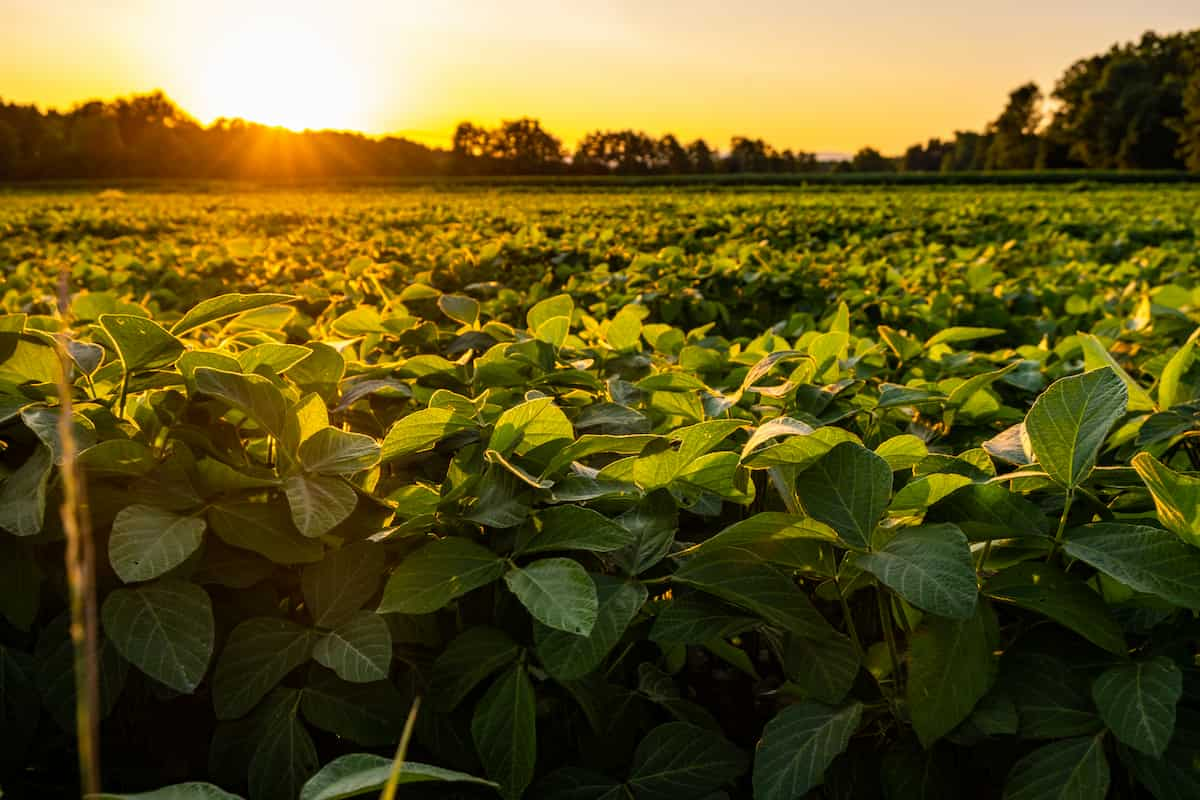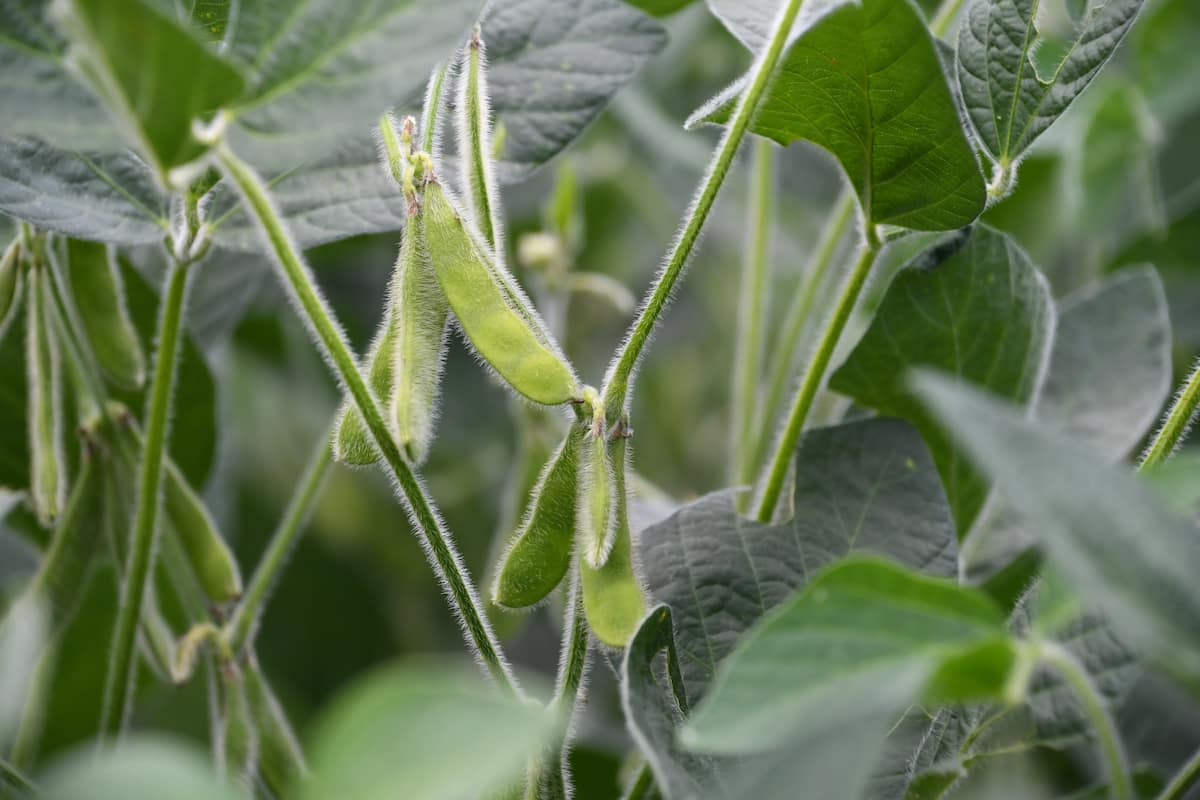Soybean farming has grown in popularity in Wisconsin due to its economic and environmental benefits. Soybeans are a versatile and valuable crop, providing a source of protein, oil, and even biofuel. The state’s favorable climate and increasing demand for soybean products make it an attractive option for farmers looking to diversify their operations.

Below we learn about the step-by-step process of establishing a successful soybean farming operation in Wisconsin, including planting, maintenance, and harvesting tips. We will also cover soybean planting spacing, varieties, and the Wisconsin climate’s impact on soybean farming.
How to Start Soybean Farming in Wisconsin
Assessing and Preparing the Land
Before planting soybeans, assessing the soil type, fertility, and drainage of your land is essential. Soybeans thrive in well-drained, loamy soils with a pH between 6.0 and 6.5. Do a soil test to determine how many nutrients are in the soil and the pH level. If needed, fix with lime or fertiliser. Ensure proper drainage by installing tile drains or constructing ditches to prevent waterlogged conditions that can harm the plants.
Choosing the Right Soybean Variety
Wisconsin’s climate offers a range of soybean varieties suited to different growing conditions. Early-maturing varieties (Group 0 to Group II) are ideal for northern regions while mid- to late-maturing varieties (Group II to Group III) are better for southern regions. Consider disease resistance, yield potential, and local market demand when selecting the right variety for your farm.
Planting Timing and Spacing
Optimal planting time in Wisconsin is typically late April to early June, depending on weather conditions and soil temperatures. Soybeans require soil temperatures of at least 50°F for successful germination. Planting too early can reduce germination rates and increase the frost damage risk.
Soybean planting spacing is crucial for maximizing yields. A row spacing of 15 to 30 inches is recommended, with narrower rows favored in higher-yielding environments. Aim for a final population of approximately 100,000 to 140,000 plants per acre, depending on your specific variety and target yield.
Fertilization and Nutrient Management
Based on your soil test results, apply the necessary fertilizers and amendments to provide adequate nutrients for your soybean crop. Soybeans typically require nitrogen, phosphorus, potassium, and micronutrients like iron, manganese, and zinc. Use split nitrogen applications, applying a portion at planting and the remainder during the growing season. Inoculating the seeds with nitrogen-fixing bacteria can also enhance the plants’ ability to fix atmospheric nitrogen, reducing the need for additional nitrogen fertilizer.
Weed Control
Soybeans are sensitive to competition from weeds, which can reduce yields if not managed effectively. Implement an integrated weed management strategy, combining cultural, mechanical, and chemical control methods. Start with a clean seedbed by using tillage or herbicides before planting.
Employ mechanical methods like cultivation or rotary hoeing to control weeds in the early stages of growth. Finally, consider using pre-emergence and post-emergence herbicides, selecting products that are effective against your specific weed species and compatible with your soybean variety.
Pest and Disease Management
Check your fields regularly to monitor for insect pests and diseases. Common pests in Wisconsin soybean fields include soybean aphids, bean leaf beetles, and Japanese beetles. Employ integrated pest management techniques, such as rotating crops, planting resistant varieties, and using biological control agents to minimize pest pressures.
In case you missed it: How to Start Corn Farming in Wisconsin: A Step-By-Step Production Guide for Planting to Harvest

When necessary, use insecticides judiciously and according to label directions to control infestations. Diseases affecting soybeans in Wisconsin include soybean cyst nematode, sudden death syndrome, and white mold. Preventive measures, such as crop rotation, resistant varieties, and proper planting dates, can help reduce the risk of disease. If a disease is detected, consult a local extension specialist to determine the best action.
Irrigation and Water Management
While soybeans are relatively drought-tolerant, supplemental irrigation may be necessary during periods of prolonged dry weather to ensure optimal growth and yield. Monitor soil moisture levels and irrigate when necessary to maintain adequate moisture throughout the growing season. Don’t water too much, because that can cause diseases and stunt root growth. Use efficient irrigation methods, such as drip or center pivot systems, to conserve water and minimize runoff.
Harvesting
Soybeans are typically ready for harvest when the plants have reached physiological maturity, indicated by 95% of the pods have turned brown or tan, and the seeds have a moisture content of around 13-15%. Harvesting at the appropriate moisture level helps reduce seed damage and ensures optimal storage conditions. Use a combine harvester equipped with a flex head to efficiently harvest the crop. Adjust the combine settings to minimize seed loss and damage during the process.
Post-Harvest Handling and Storage
Proper handling and storage of harvested soybeans are essential to maintain seed quality and minimize losses. Clean the soybeans to remove debris and damaged seeds, and dry them to a moisture content of 12-13% for long-term storage. Use aeration to maintain a uniform temperature and moisture level in the storage facility. Regularly monitor the stored soybeans for signs of insect infestation or mold growth and take appropriate action if problems are detected.
Marketing Your Soybean Crop
Develop a marketing plan for your soybeans that considers local market demand, pricing trends, and transportation costs. Consider diversifying your marketing channels by selling to local processors, exporting to international markets, or exploring niche markets like organic or non-GMO soybeans. Stay informed about changes in market conditions, government programs, and global trade policies that may impact your soybean business.
In case you missed it: How to Start Potato Farming in Wisconsin: A Step-By-Step Production Guide for Planting to Harvest

Conclusion
Soybean farming in Wisconsin offers a profitable and sustainable agricultural opportunity for those willing to invest the time and resources necessary for success. You can establish a thriving soybean operation in the state by carefully selecting the right variety, managing soil fertility, and adopting effective weed, pest, and disease management strategies.
Remember to pay close attention to planting timing and spacing and monitor local climate conditions to ensure optimal growth and yield. With dedication and the application of the best management practices outlined in this guide, you can enjoy the benefits of soybean farming in Wisconsin for years to come.
- Ultimate Guide to Ossabaw Island Hog: Breeding, Raising, Diet, and Care
- Ultimate Guide to Juliana Pig: Raising Facts, Size, Diet, Care, and Lifespan
- Raising Lleyn Sheep: Disadvantages, Price, Uses, Characteristics, and Care
- Ultimate Guide to Meishan Pig: Breed Facts, Breeding, Raising, and Care
- Ultimate Guide to Teacup Pigs: Raising, Diet, Lifespan, Cost, and Care
- Guide to Raising Poll Dorset Sheep: Facts, Profile, Characteristics, Uses, and Care
- Ultimate Guide to Bighorn Sheep: Characteristics, Diet, Lifespan, Breeding, and Lifecycle
- Ultimate Guide to Raising Katahdin Sheep: Farming Facts, Breed Profile, Uses, and Care
- Ultimate Guide to Raising Oreo Cows: Belted Galloways Farming Facts, Profile, Uses, and Care